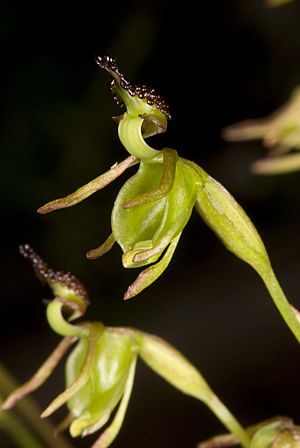Flying duck orchid facts for kids
Quick facts for kids Flying duck orchid |
|
|---|---|
 |
|
| Conservation status | |
 Nationally Critical (NZ TCS) |
|
| Scientific classification | |
| Genus: |
Caleana
|
| Species: |
minor
|
| Synonyms | |
The Caleana minor, often called the small duck orchid or flying duck orchid, is a unique orchid. It is found in eastern Australia and the North Island of New Zealand. It gets its name because its flower looks a lot like a duck in flight! This plant has one reddish-brown, grass-like leaf. It also grows up to four flowers that can be yellowish or reddish. These flowers grow on a thin, wiry stem. The parts of the flower that look like petals (called sepals and petals) point downwards. A special part, called the labellum, points upwards and has small, bumpy glands on it.
What Does the Flying Duck Orchid Look Like?
The Caleana minor is a tuberous plant. This means it grows from a special underground stem called a tuber. It is also a perennial herb. This means it lives for more than two years and has soft stems.
Each plant has a single reddish-brown leaf. This leaf is long and thin, like a blade of grass. It measures about 40 to 130 millimeters (1.6 to 5.1 inches) long. It is also about 1 to 3 millimeters (0.04 to 0.12 inches) wide. The leaf is usually folded in half lengthwise. By the time the orchid flowers, its leaf has often dried up.
The plant can have up to four flowers. These flowers are yellowish-green to reddish-brown. Each flower is about 14 to 16 millimeters (0.55 to 0.63 inches) long. They are also about 5 to 7 millimeters (0.20 to 0.28 inches) wide. The flowers grow on a stem that is about 80 to 150 millimeters (3.1 to 5.9 inches) tall.
The sepals and petals of the flower are about 7 to 10 millimeters (0.28 to 0.39 inches) long. They hang downwards. This creates a bucket-like shape with the wide parts of the flower's column. The labellum is a special part of the flower. It is about 5 to 6 millimeters (0.20 to 0.24 inches) long and 3 to 4 millimeters (0.12 to 0.16 inches) wide. It is covered with shiny black glands. The labellum is held above the rest of the flower. It sits on a sensitive, strap-like stalk about 5 millimeters (0.20 inches) long.
This orchid usually flowers from September to February. However, in New Zealand, its flowering season is a bit shorter.
Where Does the Flying Duck Orchid Live?
The small duck orchid grows in eastern Australia. It is also found on the North Island of New Zealand. In Australia, it is quite common and can be found in many different places. It often grows on hills and slopes in forests.
In Queensland, you can find it south of the Carnarvon National Park. It grows in the eastern part of New South Wales. It can be found as far west as Dubbo. It also lives throughout Victoria, except for the far north-west. You can also spot it in the south-east of South Australia and in Tasmania.
In New Zealand, this orchid is currently only known from Whakarewarewa. This area is near Rotorua. Experts consider it "critically threatened" there. This means it is in great danger of disappearing. There were two other places it was recorded in New Zealand. One was in Kaitaia and the other at Waiotapu.
Scientists are not sure if the species is native to New Zealand. Some think it might have been brought there by accident. One idea is that seeds arrived from Australia. They might have been carried in mud on someone's shoe. Another idea is that bushfire smoke blew the seeds from Australia.
How the Flying Duck Orchid Pollinates
This orchid relies on insects to help it pollinate. Pollination is how plants reproduce. The labellum, which is the special part of the flower that looks like a duck's head, is held up by a sensitive stalk.
When an insect lands on or touches the labellum, something amazing happens! The labellum quickly snaps downwards. This action traps the visiting insect between the labellum and the broad parts of the flower's column. The insect then helps to carry pollen from one flower to another. This clever trick helps the orchid make new seeds.

